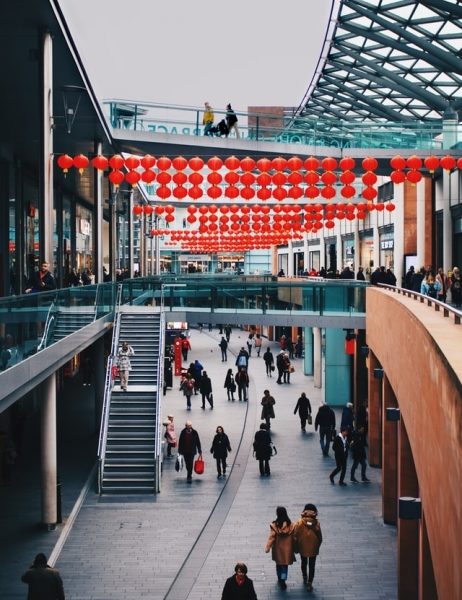As we look towards a post-COVID recovery, our Policy Lead Will Thomson explains why local authorities need to refocus their investments towards putting people and the planet first.
Through our work with Tortoise on the COVID-19 and Communitiesproject, we’ve seen unparalleled collapses in consumer spending. This halt to economic activity will have wide and far reaching consequences on public finances for years to come. We’ve also seen in the latest releasetoday by the Office for National Statistics on Gross Domestic Product (GDP), that GDP in the UK fell by 2.0% in Quarter 1 2020, showing the first significant hit to the UK economy caused by the Coronavirus. At a local economic level, as the Public Accounts Committee undergoes its inquiry into local authority commercial investment, we’re interested in exploring the immediate impact that coronavirus is having on an increasingly-common form of local authority investment: the purchase of shopping centres.
To provide some context, a recent NAO report found that local authorities spent £6.6bn on commercial property between 2016-17 to 2018-19, with one in five shopping centres bought since 2016 acquired by local authorities. However, the market context for shopping centre investment is a largely grim amidst poor returns, declining footfall and shifting consumer behaviour – this is before considering the economic impact of the coronavirus pandemic. The changes being seen in the retail sector are deep and structural. As e-commerce has grown steadily over the decade, footfall in high streets, retail parks and shopping centres has declined by 10% over the past 7 years.
Using the anonymised open banking data on merchant sales and consumer wallet spend at ward level, generated for us by the Impact Information Company (Imfoco), we have taken a look at the impact of the coronavirus pandemic on shopping centres that have been purchased by local authorities over the past five years. The following table includes some five recent local authority investments picked out. The percentage drop is for the week 8 – 14 April over the same period last year.
Table 1 – Year-on-Year Percentage Decline in Total Sales in Shopping Centre Wards (8 – 14 April)
| Local Authority Purchaser | Shopping Centre | Cost (Millions) | Year | Sales Decline (YOY) |
| Canterbury City Council | Whitefriars, Canterbury | £154.5[1] | 2018 | -85.78% |
| Shropshire County Council | Darwin / Pride Hill, Shrewsbury | £52 | 2017 | -85.11% |
| Blackpool Council | Houndshill Shopping Centre, Blackpool | £47.5 | 2019 | -83.83% |
| Trafford Council | Stamford Quarter, Altrincham | £14 | 2019 | -78.98% |
| Stockport Council | Merseyway, Stockport | £80 | 2016 | -63.81% |
This provides a small snapshot of the immediate impact on local economic activity in the wards where each shopping centre is located. Drops in consumer spending would be expected because of the closure of all non-essential shops, but this collapse in economic activity will likely persist until at least July, when there are more significant relaxations to the lockdown planned. Total sales are therefore likely to remain lower than the baseline for the foreseeable future, as prolonged social distancing measures impact consumer behaviour (e.g. accelerated shifts toward online retail; declining footfall due to limits on the amount of people allowed in shops at the same time).
The economic shock of COVID-19 will have an impact on the long-term viability of any commercial investment and is likely to exacerbate the risks borne by the local authority purchaser – especially in the case of shopping centre investments, which were already underperforming before the pandemic hit.
While we support local authorities investing in their administrative area, we think this should be done in ways that support local economic development in sustainable and resilient ways: investing in a social and green economy that puts people and the planet first – raising living standards, enhancing physical and mental wellbeing and tackling entrenched inequalities.
Some local authorities have been exploring innovative investment models to support their strategic priorities: West Berkshire Council has recently approved the UK’s first Community Municipal Investment, offering residents and community groups an opportunity for long-term, low-risk investments alongside the council in projects that align with the council’s environment strategy. Similarly, Stoke-on-Trent and Hackney councils have made pioneering investments in local energy projects that will benefit residents and businesses while paving the way to a low-carbon future
At SIB, we are interested in developing fairer models of regeneration that recycle wealth within a local area, and which avoid this wealth being extracted by a set of private investors. We want to give voice to the organisations and communities we strengthen by listening and responding to their needs. This means taking a data-led approach that utilises local economic modelling to target funding where it can be most effective, while ensuring any investment enhances the social and economic capacity of an area.
There will be a real and urgent need for investment after the pandemic to rebuild and regenerate local economies. The impact of this pandemic is likely to further entrench existing inequalities in the UK – many of the most vulnerable communities will struggle to bounce back when the social distancing measures are eased. The places that have been already been very badly hit – such as coastal towns heavily reliant on tourism – had very little resilience to this kind of crisis in the first place.
The Coronavirus has exposed the need for a fresh approach to how we invest in places and, in this new context, the purchase of a shopping centre as a traditional retail investment seems both risky and lacking in ambition. Instead, as we enter the recovery period, rebuilding fairer communities will require patient, flexible investment that develops social and green infrastructure, that provides good employment and secure incomes to local people, and that channels profits back into to the local area so that communities can flourish.
Data Notes
[1] This is the total amount Canterbury council has invested in Whitefriars: having originally purchased 50% of the shopping centre in 2016 for £79m, it then spent an additional £75.5 to become full owner in 2018.
Photo by Jorge Percival on Unsplash




